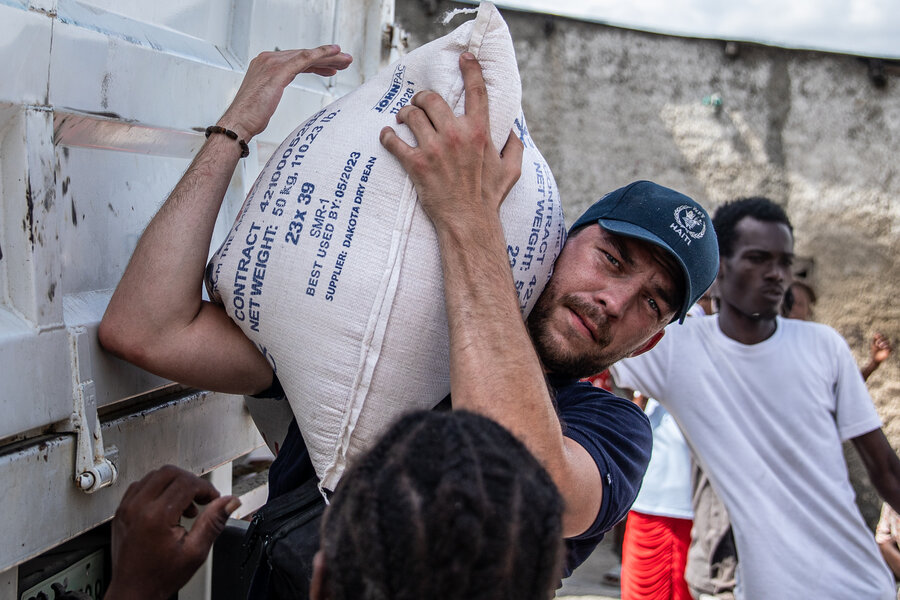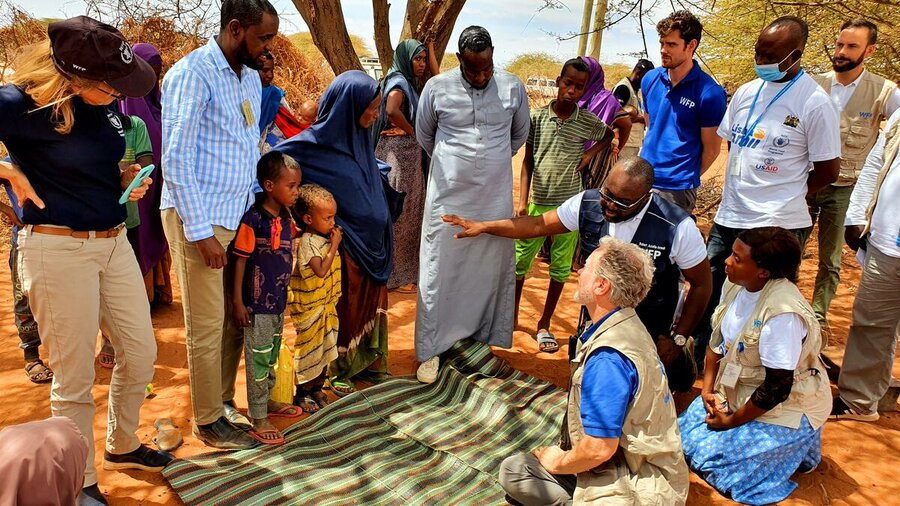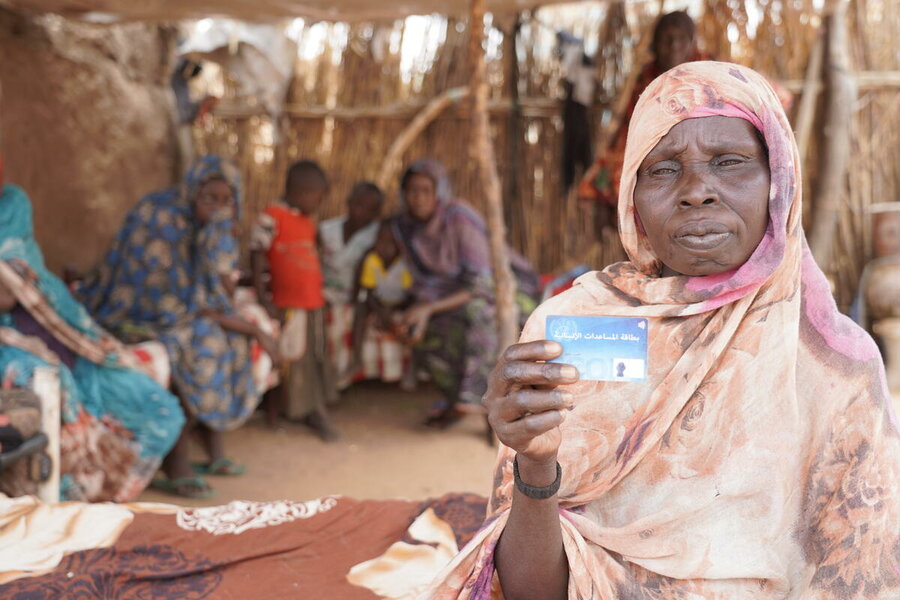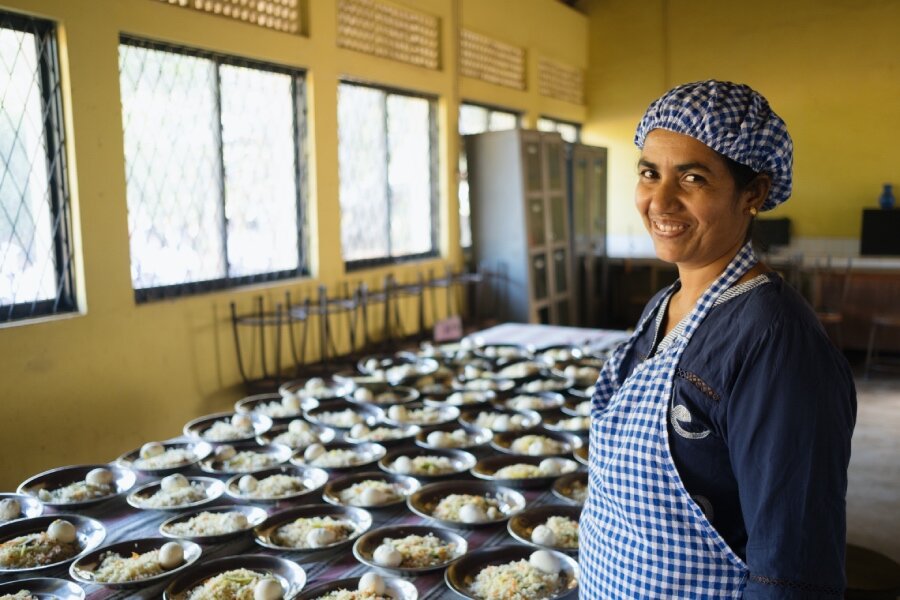World Food Day: Soaring prices, soaring hunger
In Haiti, the poorest country in the Americas, spiking fuel and food costs have fed growing violence and catastrophic hunger levels in some places, a new expert report finds— while in others, many Haitians like mother-of-four Adeline, can only afford one meal a day.

As Sudan grapples with soaring food prices and alarming child malnutrition, World Food Programme (WFP) rations help to keep Hauwa Mustapha and her 10 children alive.
In Lebanon, where food costs have jumped 16-fold over three years, Rana’s children sometimes cry from hunger.
And Sri Lanka’s worst economic crisis in decades has imperiled the country’s national school meals programme, among other key national safety nets, almost forcing cook Sriyani Kusumalatha to go out of business.
There is little to celebrate this World Food Day (16 October), as a global food crisis leaves hundreds of millions of people battling acute hunger—with some tipping dangerously close to famine. Along with known culprits—the fallout of conflict, COVID-19 and climate change —is another fearsome enemy: skyrocketing prices for food and other key basics, especially since the war in Ukraine.
“Since this conflict began, soaring food, fuel and fertilizer costs have driven an additional 70 million people closer to starvation,” WFP Executive Director David Beasley said recently. “What was a wave of hunger is now a tsunami of hunger.”
Today, a record 345 million people in 82 countries face acute hunger or worse—up from 282 million at the start of this year.
Sharply rising prices also threaten hard-won gains in building longer-term food security and resilience, as humanitarian agencies like WFP now struggle to reach growing numbers of desperate people with shrinking resources.

WFP’s monthly operating costs are more than US$28 million higher today than in early 2022. And while global prices have dropped slightly in recent months, they still are at a 10-year high.
High prices have left WFP and other humanitarians scrambling to plug widening funding gaps—even as donors must choose among a growing number of competing demands. As our needs outstrip available resources, WFP is forced to slash or stretch food and cash assistance to many hungry people, to prioritize the most desperate.
Four countries in four different parts of the world—Haiti, Sudan, Lebanon and Sri Lanka—illustrate the destructive intersection of soaring prices and sometimes deadly hunger that is endangering whole generations.
Haiti’s cycle of desperation
In Haiti’s southeastern commune of Les Cayes, Adeline recalls trying to sell bananas from her region in the capital Port-au-Prince. But after two trips to the city, her budding venture ground to a halt.
“I couldn’t go anymore,” Adeline says. “Because of the insecurity, I lost the business, I lost the money, and now I have to stay here without doing anything.”
Spiking prices have compounded Haiti’s overlapping crises, as its economy plummets, soaring violence blocks ports, roads and Haitians in their homes, and nearly half the nation’s population face crisis hunger levels, new findings show.
In a first for the country, catastrophic hunger or IPC5—the worst category possible—has been recorded in the City Soleil neighborhood of Port-au-Prince, according to the report by the Integrated Food Security Phase Classification, or IPC. It finds another 1.8 millionHaitians face emergency hunger levels, just one notch below.
“The products cost much more now because the same money from before can't buy the same amount anymore,” says Adeline, the banana seller. “If there is food, we eat twice a day, if there is not, we eat only once. For the moment, we only eat once.”

“The Haitian people have gone through a gauntlet this year,” said WFP Haiti Country Director Jean-Martin Bauer. “First of all with gang violence, with increasing food prices and inflation, and over the past four weeks a lockdown that’s brought the country to a standstill.”
Despite the volatility, WFP has reached more than 100,000 people with emergency food assistance in the Port-au-Prince area so far this year. We aim to scale up to reach 1.7 million with support to strengthen social protection and food systems that are key for the country’s recovery and longer-term development.
In the northern commune of Limbe, for example, 60-year-old mother-of-six Dozimene earned US$70 monthly for participating in a WFP programme rehabilitating flood-hit irrigation canals and roads.
“These works really changed my and my children’s lives,” says Dozimene, who used the money for food and transport and funneled the rest into a small business selling detergents at the market.
Sudan: growing hunger, shrinking hope
At the Al Salaam camp for internally displaced persons in Sudan’s North Darfur State, packed with thousands of conflict-displaced people like herself, Hauwa says the price of a simple cup of flour has doubled in just a few months.
Uprooted more than two decades ago when militia attacked her North Darfur village of Tarni, Hauwa has watched her children and now grandchildren grow up in the camp.
With Sudan’s food prices climbing nearly 144 percent in a year, she can barely afford basics like oil, sugar and flour with the WFP cash assistance that she receives. Other income options are nearly non-existent.

“In the market, there are no jobs. The prices for okra, bread, sugar and oil are all going up,” Hauwa said. “This is how we are living now. We just leave it up to Allah [God].”
She is not alone. A mix of high prices, instability, conflict and climate shocks have left some 15 million people—one-third of the population — facing hunger. Millions of children suffer acute malnutrition, and may risk dying without treatment.
As needs soar, WFP and other humanitarians face a funding crunch, hampering our ability to reach 9.3 million of Sudan’s most vulnerable people with assistance by year’s end.
“Concerted action is required to prevent people from slipping further into hunger,” WFP Sudan Representative and Country Director Eddie Rowe said recently, in a joint appeal with other UN agencies.
Feeling respected in Lebanon
In the northern Lebanese city of Tripoli, Rana also worries about her children’s welfare as the country’s crumbling economy, political turmoil and the Ukraine war hike up costs and poverty in the import-dependent country.
“The hardest thing when you have kids is seeing them cry because they are hungry,” she says.
Food prices have increased 30 percent this year alone—and more than 1,500 percent since Lebanon’s crisis erupted in 2019. More than half of all Lebanese, and nearly nine in 10 Syrian refugees in the country, need humanitarian assistance.
Inflation has also sharply driven up the cost of WFP’s basket of staple foods that we deliver to the country’s hungriest.
Today, however, Rana is cooking up a meal on a simple gas burner — thanks to food she bought with WFP cash.
“When you’re able to provide your kids with something that makes them happy..it is a great joy,” says Rana, as she places a generous platter of pasta and pita in front of them.

In the capital Beirut, 53-year-old Ahmed Sbaity also counts among some 1.72 million people—or one in three countrywide, including Syrian refugees—who receive WFP food assistance. His comes by way of a monthly WFP food parcel, that includes products like rice, pasta, tuna, lentils and oil.
“This package came as a salvation,” says Sbaity, who feared receiving food assistance would be humiliating. But it wasn’t.
“I felt respected,” he said. “I felt I was picking up my own food from the supermarket.”
Sri Lanka’s ‘Food Aunty' back in business
In Sri Lanka, the country’s worst economic crisis in nearly a quarter-century has left 6.3 million people, or nearly 30 percent of the population, food insecure. Food inflation in August soared to a record 94 percent.
The high prices are also destroying livelihoods. They almost forced caterer, Sriyani Kusumalatha, to give up hope and hang up her pots and pans for good.
“The children call me Kaema Nanda (food aunty).” Sriyani says of her job as a school meal caterer, where she provides meals to 90 children at a primary school in the country’s central Matale District. “As soon as I enter the school gates, their first question to me is, ‘what did you bring for us today?’”

Sriyani counts among thousands of mothers who cook and serve daily meals to one million children enrolled in the national school meal programme. But fluctuating food prices made it increasingly difficult for her to afford her market-purchased ingredients.
That changed, after Sriyani enrolled in WFP’s ‘Home Grown School Feeding’ project, which provides the caterers with the knowledge and inputs —from saplings and chicks to water motors and pipes—to sustain their business. Today, Sriyani cooks fresh and nutritious meals for young students using ingredients fresh from her garden.
Her harvests not only meet the food needs of the local primary school and her family, but she sells the surplus to her neighbours at lower-than-market prices — helping her community access healthy food amid ongoing economic shocks.
Now financially independent thanks to WFP’s support, Sriyani says she feels “empowered to continue my business on my own.”
